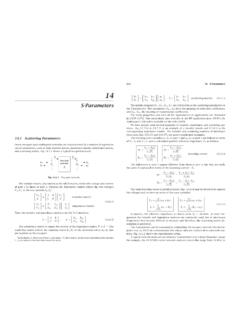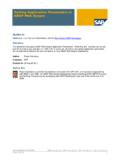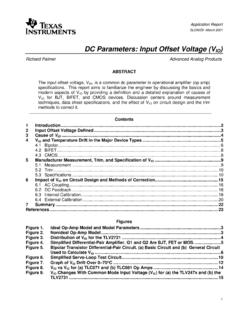Transcription of MISSION PARAMETERS - organizational health
1 MISSIONPARAMETERSWHAT IS organizational health ? organizational health is defined as an organization s ability to function effectively, to cope adequately, to change appropriately, and to grow from within. organizational health consists of the following ten dimensions: Goal Focus - the ability of persons, groups, or organizations to have clarity, acceptance, support, and advocacy of school-wide goals and objectives. Communication Adequacy - that state when information is relatively distortion free and travels both vertically and hori-zontally across the boundaries of an organization. Optimal Power Equalization - the ability to maintain a relatively equitable distribution of influence between the leader and members of his/her work unit. Resource Utilization - the ability to coordinate and maintain inputs, particularly personnel, effectively with a minimal sense of strain.
2 Cohesiveness - the state when persons or groups have a clear sense of identify, are attracted to membership, want to stay, and are willing to influence and to be influenced. Morale - that state in which a person, group, or organization have feelings of security, satisfaction, well-being, and pleasure. Innovativeness - that ability to be and allow others to be inventive, diverse, creative, and risk-taking. Autonomy - that state in which a person, group, or organiza-tion have the freedom to fulfill their roles and responsibilities. Adaptation - that ability to tolerate stress and maintain stabil-ity while changing to meet the unique needs of their stake holders. Problem-Solving Adequacy - an organization s ability to per-ceive problems and to solve them with minimal energy.
3 Prob-lems get solved, stay solved and the problem solving procedures are IS organizational health MEASURED?Individuals respond to the response forms during a regular or special meeting and follow established protocols to ensure the integrity of the data. The data are analyzed and reported back to the district. The scores are converted into percentile scores based upon national norms for elementary, middle, junior high, comprehensive high schools, specialty schools, and central office units. Individuals receive a 50 to 80 page Individualized IS IT IMPORTANT TO MEASURE?The authors of the international McKinsey Report, How the Best-Performing School Systems Come Out on Top, stated that All of the top-performing systems recognize they cannot improve what they do not measure.
4 Furthermore, they stated that Monitor-ing outcomes allows them to identify and spread best practices, to pinpoint areas of weakness, and to hold schools accoutable for their results. The MISSION of the organizational health Diagnostic and Development Corporation (OHDDC), a premier catalyst for systemic change, is to enhance an organization s leadership capacity by providing principle-centered, data-based, and cost-effective has developed an extraordinary repertoire of resources to: Diagnose the internal state of an organization as measured by the ten dimensions of organizational health . Identify leadership and organizational strengths and improvement priorities that permeate the district. Display these data in conceptual models that provide frameworks for moving individuals and teams from Dependence to Independence to Interdependence.
5 Provide a systematic, collaborative process for helping leaders improve their leadership and organizational skills through the use of effective coaching models. Facilitate the development and implementation of structures and strategies necessary to accomplish district-wide goals. Utilize principle-centered Leadership Belief Statements to facilitate the alignment of decisions throughout the system. Provide a conceptual infrastructure as the basis for establishing, maintaining, and/or modifying systems necessary for sus-tained of these diagnostic and development services will improve the critical dimensions of organizational health that are statisti-cally correlated with increased performance and productivity. The results are measurable and lead to Sustained Systemic IS THE PROCESS?
6 The organizational health Improvement Process is a data based approach and is designed to help leaders improve their leadership and organizational effectiveness. The cyclical improvement process includes an Orientation, Data Collection, Overview of Data, Interpretation and Resource Team Conferences, Team Training and follow-up and support sessions. The objective is to place leaders in a positive and proactive position to use the data and our support systems in order to improve the effectiveness of their administrative OHReport4 InterpretationConference5 PracticeTime7 Share OH8 PlanningSession9 TeamTrainingSession10 ImplementPlan ofAction11 Follow-UpSupport6 Resource Team ConferenceOrganizationalHealthImprovemen tCycleIS THERE EVIDENCE THAT organizational health IMPACTS STUDENT PERFORMANCE?
7 The statistically significant relationship between the dimensions of Organi-zational health and student performance has been documented for the past two decades. Most of the following publications and presentations provide evidence of this important relationship and are available for review @ (click on publications) Enhancing Leadership Effectiveness, Marvin Fairman and Leon McLean, Paradigm Media Publishing, 2011. (Chapter 8) Alan Ingram, Springfield Public Schools: Creating a Culture of Educa-tional Excellence, District Management Journal, Winter 2011. Leon McLean, Marvin Fairman, and Bob Moore, A System Approach to Charting A Path to Quality and Achievement, The Council of Chief State School Officers Successful Practices Series, Summer 2006.
8 Dennis Dearden and Marvin Fairman, Building the Foundation for Successful Change as a New Superintendent, AASA Break-Out Session, Executive Leadership, February 17, 2011. Marvin Fairman, Alan Ingram, and Bob Moore, Using Data to Trans-form the Culture of Schools and Central Office Units, AASA Break-Out Session, Management, February 17, IT BE HELPFUL TO HAVE RELIABLE AND VALID DATA SIMILAR TO THE SAMPLE BELOW?The scatter plot below shows the relationship between a Student Perfor-mance Index and Adaptation for all 31 schools in this organization. The performance Index was based on a three year average of percent of students who met standards on Reading, Math, Science, and Writing. The Adap-tation score is also based upon a three year average for these schools.
9 The diagonal line, a regression line, was drawn by a computer program and shows that this relationship was statistically significant at the .001 level of significance. We know based upon these data from this representative district that student performance is significantly impacted by the degree of support faculty members have for the goals and initiatives needed for goal accomplishment. The critical mass of teachers at these different conceptual levels will be using very different language. For example: At the clarity level, I know what the principal wants but those expectations are unrealistic. These kids just can t do that because .. At the acceptance level, they know what the principal wants and expects and they accept these goals and initiatives, but they need as-sistance.
10 They have the want to but may not know how to adapt and make the needed changes. At the support level, the language changes to our goals and we can make the needed changes. However, they also need support and encouragement from the principal. At the Advocacy level, teachers are willing and able to make the needed changes and they are willing to hold each other accountable for results. Many of these schools at the Support Level achieved advocacy level in Year Three; however, these symbols represent a three year aver-age on this important scatter plot data and the conceptual framework provide the supervisor of these schools with powerful information that can be used to: reinforce the efforts of those principals who have moved their schools to the support and advocacy levels for needed changes, identify and to capitalize on the best practices that these principals have used to gain support and advocacy from teachers, help principals in schools at the clarity level to reevaluate and to modify the way they are initiating needed changes, provide targeted training for principals and key faculty leaders in schools at the clarity level, and to help principals develop specific strategies for moving their school to the next level.








